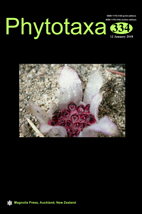Abstract
Microorganisms of subaerial biofilms, which develop on the surface of stone monuments, have been widely studied due to their impact on Cultural Heritage deterioration. Nevertheless, these extremophile microorganisms are poorly characterised. In this study, a cyanobacterial strain isolated from an archaeological zone in north-central Mexico was characterised through a polyphasic study based on ecological, morphological, and molecular data. Phylogenetic analyses were done using sequences of the 16S rRNA gene and the 16S-23S ITS region. Based on the polyphasic data, a new species corresponding to the genus Nodosilinea is described. This alkaliphilic species has optimum growth at pH of 9. Its fatty acid profile indicates that C18:1, 9E and C16:0 are its most abundant fatty acids. Extracellular polymeric substance production was verified on this strain. Only a few species of the genus Nodosilinea have been documented and described, and this is the first report of their presence in central Mexico. Hence the name Nodosilinea chupicuarensis sp. nov. is proposed.

